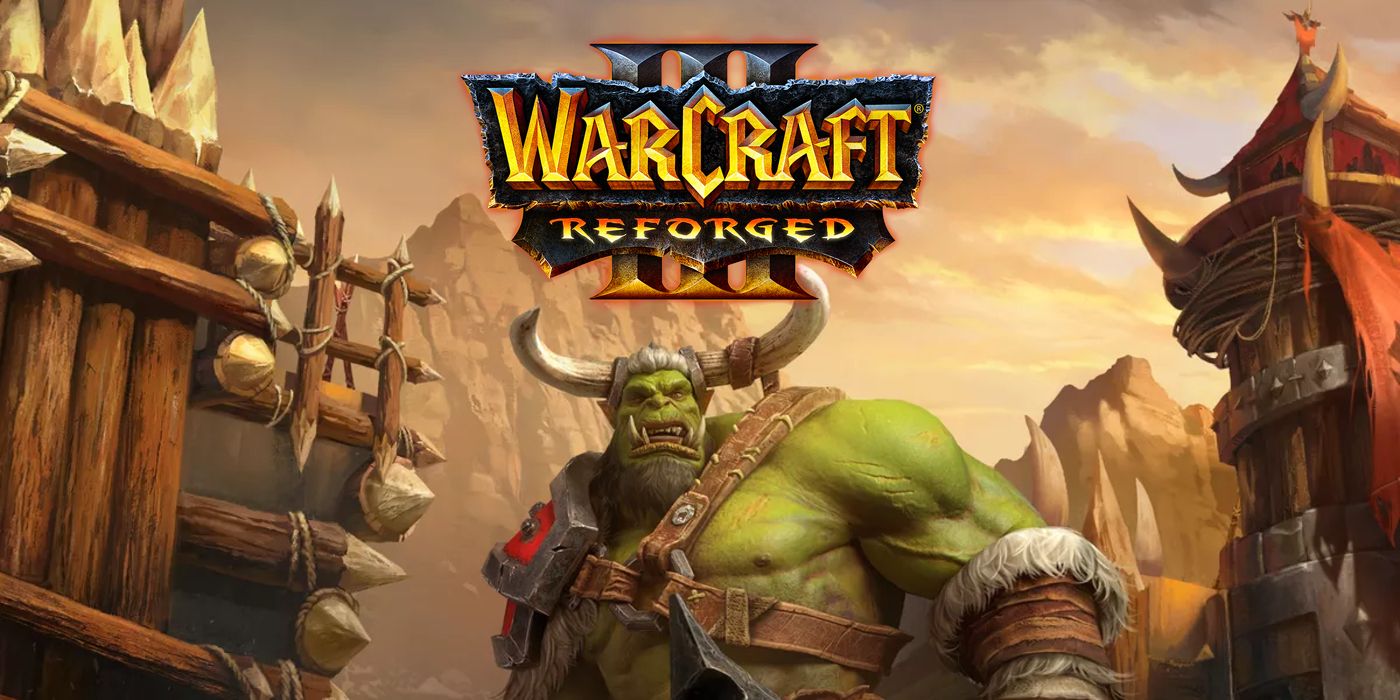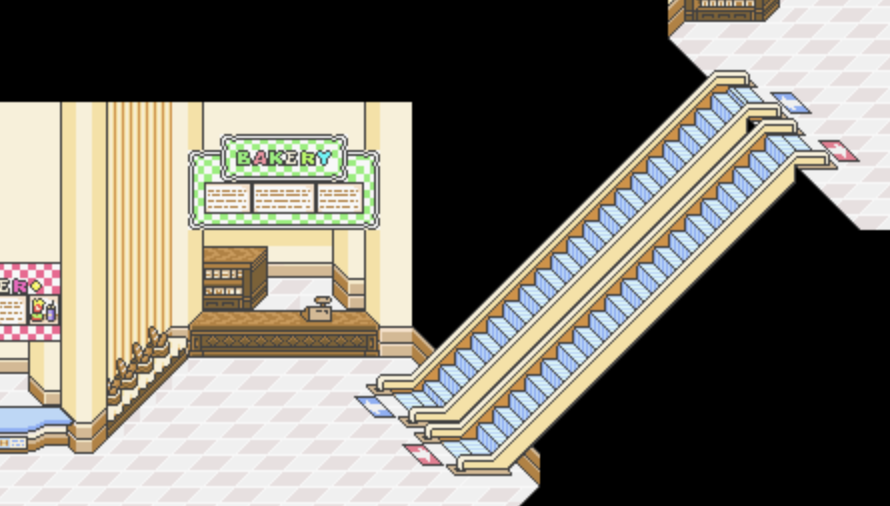
In the closing days of 1993, id Software released Doom, and the gaming world was changed forever. A landmark title that arguably established the first person shooter (FPS) genre, it was technically and artistically foundational, became one of the top selling and critically acclaimed games of all time, and even sparked a moral panic over its violence. And recently, as Doom turned 30, its cultural impact can still be felt. It’s hard to overstate what a big deal Doom was.
Yet Doom was not the first big deal by id Software, nor was it the first FPS. Little more than a year prior, id released Wolfenstein 3D, an action-packed and immersive 3D shooter that many consider the “grandfather of FPS”, and topped many game-of-the-year lists. Compared to Doom, it was clearly inferior, but through its frenetic pace and ultra violence, it was easy to see where Doom came from. Even as id slaved away at breakneck pace making Doom, competitors saw Wolfenstein 3D and the possibilities of immersive 3D gaming and rushed to make clones and their unique spins on the emerging paradigm. Some knew that id was coming up with something big but few anticipated how utterly massive Doom would become.
And thus we are left with the gaming and cultural behemoth that was Doom, and in its wake, lie numerous could-have-beens, hopelessly overshadowed and forgotten. Some were quality games that could have enjoyed great success, some were decent and could have sustained the budding studios behind them, and some were, well, forgettable me-toos that nevertheless could have built modest followings. In this post, as we look back on 30 years of Doom, let’s also look back on the the losers of history, the games that deserved more love than they did, in the shadow of Doom.
Rise of the Triad
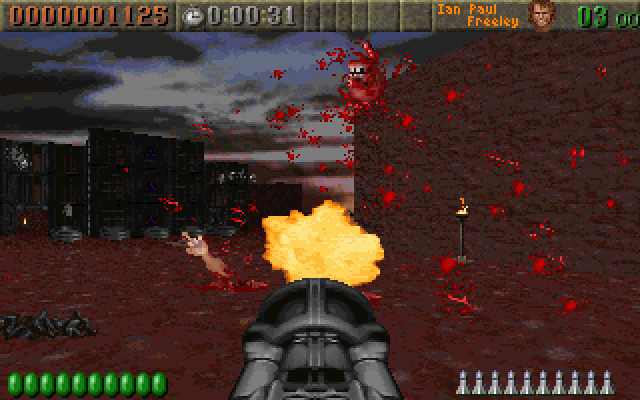
Rise of the Triad is a fun and frenetic game released in late 1994. With a mix of 1940’s machine guns and occult fantasy weapons, a paper-thin plot about shooting cultists on an island, and pretty crazy weapons (like the “Drunk Missile”), ROTT is quite the mad romp and built a modest following… mostly among people who happened to miss out on games like Doom and Duke Nukem 3D. Because it was hopelessly obsoleted by Doom, coming out a full year later.
ROTT was based on old tech. Originally conceived as a sequel to Wolfenstein 3D, its tech and design followed lead designer Tom Hall when he left id to Apogee due to creative differences, as the former wanted to focus on making Doom. To add to the troubles, id later withdrew the license to the Wolfenstein franchise, which meant ROTT’s developers had to repurpose the game’s concept. With an aging Wolf 3D engine, recycled assets and an inexperienced team, they were no match for id at their peak. ROTT’s belated release received a mild reception and it was quickly overshadowed by games around the same time such as Doom II and Duke Nukem 3D.
Which is a great shame when you consider ROTT’s history, and what it achieved had it been built by an experienced team according to its original vision. Originally a sequel to the hit game Wolfenstein 3D, it had a respectable number of innovations, such as dynamic lighting, different player characters, smart enemies, zany traps like moving fire walls, jump pads, rocket jumping, and capture the flag. And yet its age also showed, in its entirely flat levels, tile-based, 90-degree walls, and overall bland game design.
Unlike many games in this list, this one has a mostly happy epilogue. ROTT’s modest sales was enough to sustain development for Duke Nukem 3D, the big hit that cemented 3D Realms’ (nee Apogee) place in FPS history. Hall stayed at 3D Realms, later moving to Ion Storm with fellow id alum John Romero and produced a few hits too. ROTT itself enjoyed not just a remake in 2013, but also a remaster in 2023, which means there’s no better time to check this game out. For my money, any game with a gore level setting is worth getting.
References
Wolfenstein 3D
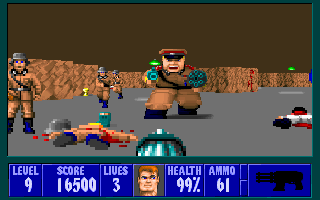
It is only natural that Doom would overshadow its predecessor, Wolfenstein 3D. Released in mid-1992, little more than one year before Doom, it racked up game-of-the-year accolades, blew past sales projections, and gave id the confidence and funds to undertake Doom, their most ambitious project yet. It seems that everyone couldn’t get enough of the fast action, spectacular (for the time) 3D environment, and the sadistic joy of mowing down hordes with a chaingun.
When Doom arrived on the scene, it stole the spotlight and everything changed. This is not surprising, because it seems Doom is everything Wolfenstein 3D was, but so much better, and so much more. Doom had projectile weapons, splash damage, shotguns, all with different kinds of ammo, Wolf 3D had a handful of hitscan weapons and one kind of ammo. Doom had a freakin’ chainsaw and a berserk powerup that let you punch demons to death, Wolf 3D had a pathetically weak stabby knife. Doom had angled walls, variable elevations, big courtyards and sky boxes, Wolf 3D was trapped indoors with grid-based 90-degree levels with a single flat colour for ceilings and floors. Doom had monster boxes, traps that turned off all the lights to scare the crap out of you, Wolf 3D had… push walls that slowly revealed a few secret items. Doom had you shooting demons, Wolf 3D let you kill Nazis and Hitler… oh wait, that’s pretty awesome actually.
These days, especially for people who did not live through that era of gaming, Doom is so much more prominent than Wolf 3D. Most people have not even heard of Wolf 3D. And given how much better Doom is, this might seem well-deserved, except… have you given Wolf 3D a try lately? Doom holds up today, and Wolf 3D may not have aged well, but give it a go and you may be pleasantly surprised. Running around mowing down Nazi guards and hearing their broken German yelps is an experience few games give. These days you can play the game in your browser for free, in high-res with modern mouse controls and minimaps thanks to the ECWolf source port, or even as an easter egg in the MachineGames sequels. The franchise is alive and well, but if you haven’t before, you owe it to yourself to check this classic out. Spear of Destiny is cool too - but give the mission packs a miss.
Oh and shameless plug for C-Dogs SDL, which can play Wolf 3D but top-down!
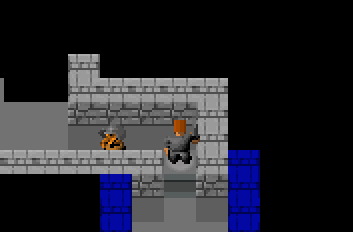
Blake Stone

In the closing days of 1993, a plucky new games studio released an innovative FPS named Blake Stone. Using the proven tech of Wolf 3D with some nifty enhancements, and a cool premise of a Bond-esque secret agent, it was a promising game, but fate would be immensely cruel - Doom released only a week later, and sales dropped off a cliff. Contemporary reviews were unkind too, given the inevitable comparisons with Doom. Doom made so many games yesterday’s news, and no other game exemplified this as much as Blake Stone.
Yet if you examine Blake Stone’s feature list, it’s clear this is no cynical cash-grab game. It featured dialogue with neutral scientists, texture-mapped ceilings and floors, distance fog, food dispensers, and a minimap for the many players who complained about getting lost in Wolf 3D. It even came with a short comic. This was a labour of love, an honest attempt at making a great game. Given the numerous enhancements, I consider this to be the best representation of what a Wolf 3D sequel would have been like. I mean, RoTT is cool but it’s a bit too crazy.
Had the game come out a few months before Doom and given some time to make an impact, I’m sure many would fondly remember the game today. And since we’re talking hypotheticals, imagine if the game had been a 007 game, it might have been very popular indeed. Sadly this game has been a permanent mainstay in bargain bins ever since the late 90’s. Today you can enjoy the game on the cheap and with some modern niceties with the BStone source port. But keep your eyes out, because the modern Wolf 3D engine ECWolf may one day promise Blake Stone support, and maybe some others too? This game is sorely awaiting a new generation of fans to rediscover it!
References
Marathon
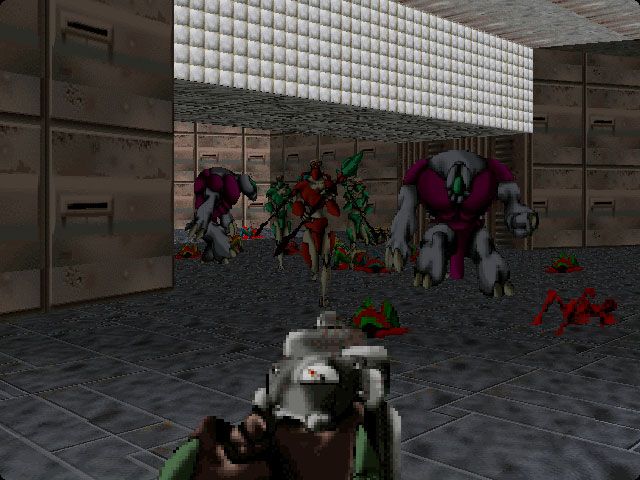
Marathon is an obscure but competent FPS, which would have been even more obscure if not for the phenomenal success of its studio’s later flagship IP: Halo. Released in late 1994, although Doom was very well established by this point, Bungie being a Mac-only studio at this point allowed them to avoid the bloodbath that was PC FPS games post-Doom, and enjoy relative success on an under-served platform. Many considered Marathon “Doom for Mac”, and deservedly so: it was technically advanced and had great gameplay.
However it was a very different kind of FPS than Doom. Slow paced, dark, creepy, and filled with lore, it played more like a survival horror, and is more akin to later games like Half-Life, in its atmosphere and storytelling via terminals. This all makes it hard to compare to Doom directly. We did get a sneak peek at what that might have been though: when the sequel Marathon 2: Durandal was released for Windows 2 years later, with slight improvements but into a super-heated FPS market (by this time games like Quake and Duke Nukem 3D were already out), sales were understandably modest.
So it’s no surprise that, despite its developer’s calibre, Marathon was heavily overshadowed, perhaps by Doom and by its Mac-only release in equal parts. As of writing, Bungie is working on a game called Marathon, which will be set in the same universe but will be a PvP-only extraction shooter, so there’s little hope of any resemblance to the original. Fortunately the original trilogy is freely available via the Aleph One project - open source, modernised, and with free assets, you can play them easily anywhere. For classic FPS aficionados that can tolerate a game that is a bit rough around the edges, and don’t expect a gameplay anything like Doom, it could be well worth checking out.
Ken’s Labyrinth

Ken’s Labyrinth is a bit of a historical oddity, in that its creator and legacy are much better known than the game itself. The game is a very quirky Wolf 3D clone, where the main character is abducted by aliens and trapped in the eponymous labyrinth, battling weird bats, spiders and robots with jellies and bouncy balls, avoiding hazards like fans and holes, while collecting magic items like potions, invisibility cloaks, or money to use in vending machines and slot machines. Escape the labyrinth, or fail to do so and doom the human race into being zapped into coal - this is quite a weird game.
The game itself is a mediocre experience, with amateurish design and artwork, although the music is charming. After a gentle first level, the game quickly reveals its labyrinthian nature, being more of a maze crawler than a fast-paced shoot-em-up like Wolf 3D. This kind of gameplay may have had its time but it has not aged well, with confusing map layouts, which even the many colourful and distinctive wall textures could not alleviate. Instead what’s most interesting is the technical prowess of the engine: without a clear design, creator Ken Silverman added feature after feature, and the engine became perhaps the most interactive FPS engine of its time: destructible walls, interactive map objects like slot machines, bouncing projectiles, homing projectiles… it’s a very hobbyist kind of approach, making things just because you can.
The game’s history is just as interesting. Written by Silverman as a mostly solo project, because he was bothered by his brother spending too much time playing Wolfenstein 3D (of all reasons), this 17-year-old coding whiz built a raycaster from scratch, and gradually added features, and with the good fortune of releasing the game in early 1993 - avoiding Doom - it sold quite well: around 100k copies. The ridiculous amount of interactivity in the engine added little to gameplay but seems to have paid off, as Silverman impressed and was later picked up by Apogee who wanted him to build the next generation of his engine - the Build engine - which went on to power Duke Nukem 3D, Blood and Shadow Warrior. Contemporary reviews raved about the amazing level of interactivity that the engine allowed, with working light switches, destructible dynamic lights, working pool tables and more. This was quite the success story, and many compared Silverman with id’s John Carmack. But Silverman soon left the commercial games industry and mostly out of the public’s eye, leaving many wondering what things could have been.
Today you can play Ken’s Labyrinth free, with modern high-res ports available, although the game is still a rough experience, as the gameplay has not aged well. Unlike Wolf 3D which still has the raw fun of machine gunning baddies, Ken’s Labyrinth is a slower, maze-crawling affair. Unfortunately this game does not get as much love compared to Wolf 3D so the quality of its modern ports is not nearly as good, as it sorely needs features like an automap. As interesting as this game is, perhaps it shall remain as an interesting chapter in the pre-history of FPS games.
References
Operation Body Count + Corridor 7
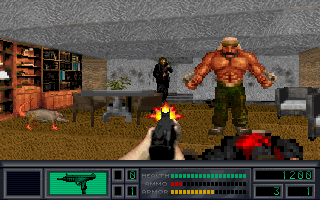
Having never played these games before, I went in with low expectations since they were preceded by their abysmal reputations - some say these were among the worst FPSs of all time! Instead I was very much surprised.
Made by Capstone Software using the aging Wolf 3D engine, being released in 1994 set these games up for failure. Capstone were not known for quality games, and these two being released in quick succession certainly did not help dispel suspicions that these were cynical attempts at cashing in on the FPS bandwagon, albeit poorly timed using outdated tech when Doom was already out. However a closer look shows these games are quite a bit better than their reputations would imply.
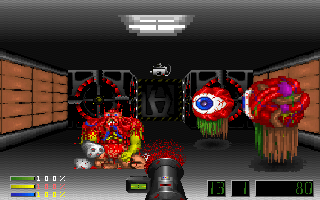
Being this late to the game, Capstone got to use an enhanced version of the Wolf 3D engine, which allowed newer effects like distance fog, animated textures, even transparent doors which allowed things like windows and portholes, as well as a cool arsenal of guns like rocket launchers and flame throwers. The games certainly look colourful and moody, and you can best see this in Corridor 7, where animated textures and sprites are used almost to a fault, with blinkenlights adorning certain weapons and walls that look like electronic screens. And using the proven Wolf 3D engine means these games still play the same, with the same fast and satisfying FPS gameplay. They certainly don’t play like the worst FPSs of all time.
This is not to say that these games were good, however. Once the initial impression wears off, it’s quickly apparent that Capstone are simply not at the same level as top-tier game studios like id. The level designs are bland and confusing, the wall textures are varied but not distinctive nor used well, such that it’s very easy to get lost and would be near unplayable if not for the automap in the enhanced Wolf 3D engine. And Operation Body Count’s truly dumb idea of starting the game in a butt-ugly and bland sewer with rats as enemies - boy did Capstone not know how to make a good first impression.
So should you bother with this game? Sadly not, since the games are not modernised at all. There is hope however, since support is on the roadmap for ECWolf, although that project moves very slowly. Until then, this game was mediocre at best for its time, and virtually unplayable today. Perhaps watch a Let’s Play if you’re really curious. Or in the words of some other reviewers, just try Blake Stone instead.
CyClones
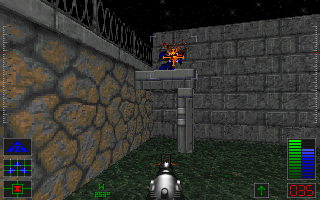
CyClones is a very obscure FPS game by venerable studio Raven Software. At the time, Raven had just made the successful first person RPG ShadowCaster, using a pre-Doom engine from id. In anticipation of the upcoming Doom release, Raven split into two teams: one to make Heretic with the Doom engine, and the other to make CyClones using older tech. Initially CyClones was planned to use the ShadowCaster engine, but it was already very outdated, so Raven made the decision to make their own in house engine.
The result is a very mixed bag. CyClones has some impressive technical innovations compared to earlier games like ShadowCaster and Wolfenstein 3D, such as sloping floors, moving platforms, and was notably the first FPS to use a mouse-aiming reticle, separate to the moving direction. The game also has nice production values, with FMV, pre-rendered cutscenes, CD soundtrack and interesting lore. However the game’s old tech base still showed, in its grid-based 90-degree levels, and its sluggish speed. Bland and confusing level design did not help. The result is a slog of a game that looks interesting, but had no chance of comparing against Doom.
Of course Raven itself did quite well despite CyClones; its sister effort in Heretic was wildly successful, and Raven will continue its long and fruitful collaboration with id in making a bunch of best-selling games. As for CyClones, I would say give it a skip; despite its few notable technical achievements, it is simply not fun to play, and is desperately in need of a modern engine refresh, to bump up its shortcomings like severely limited viewing distance and frame rates, and awkward control scheme.
The Terminator: Rampage

The Terminator: Rampage looks great in screenshots. Released in December 1993, it too shared the misfortune of coming out right around Doom and was instantly overshadowed, but imagine a pre-Doom world, if you compare it to Wolf 3D, it looks pretty good - texture-mapped floors and ceilings, more than half a dozen different weapons and different ammo types, a cool IP, and even some neat video sequences. Developer Bethesda already had 2 Terminator-based games under their belt, so this third outing - using the Elder Scrolls: Arena engine - should be pretty good, right?
Unfortunately the game just doesn’t feel that great to play. At the time it had very high hardware requirements, lagging very badly on typical hardware. Although today you can easily emulate it using much more powerful hardware, the engine just isn’t that smooth, compared to Wolf 3D let alone Doom. The enemies are also quite bland, with very samey corridors and rooms forming the majority of levels. It seems that the studio was just not as good as id at making smooth and tight gameplay that is required for FPS games.
Of course these days Bethesda are far better known for their open world RPGs, so it seems there is no interest in revisiting this historical artifact, which is just as well - it’s simply not that good, so give it a miss.
Super 3D Noah’s Ark

Here’s one from left field: a Christian-themed Wolfenstein 3D! Ok, so this game is really easy to dunk on, being made by a Christian games studio known for making other cheap knockoff-like games sold mostly in Christian bookstores to kids who weren’t allowed to play the normal, violent games. And sure, it’s not unfair to say this is just a re-skinned Wolfenstein 3D. But you’re doing this game a disservice by dismissing it so readily.
You see, Super 3D Noah’s Ark has a really interesting history. It was not conceived as a non-violent Christian game at all; the studio Wisdom Tree’s founder was a huge fan of Hellraiser (yeah, that super creepy horror movie), and spent big bucks to acquire licenses to both this and the Wolfenstein 3D engine to make a game. Having experience with unlicensed NES games, the studio aimed to release for this platform, which was incredibly ballsy given the severe technical challenges, and unfortunately could not overcome. Eventually id released Doom which pretty much killed this project, as it would have been hopelessly outdated. In an attempt to salvage some money from this project and avoid competition with Doom, Wisdom Tree decided to target the Super Nintendo with a bible-themed game that plays largely like Wolfenstein 3D. The result is quite unique - the only unlicensed SNES game, which used a pass-through cart to get around copy protection - you need to plug in a licensed cart on top of this cart, Sonic & Knuckles style.
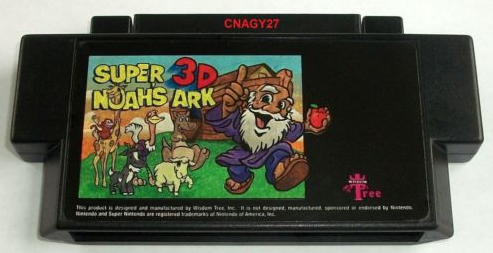
So how does the game play? Honestly, the game is mediocre at best, and naysayers are mostly right that this is like a cheap and bizarre Christian version of Wolfenstein 3D. But the game has a few surprisingly good points (and bad points). Being similar to Wolfenstein 3D, the game plays well and is generally fun. There are a few enhancements compared to vanilla Wolf 3D - a few big slingshot-like projectile weapons in addition to the hitscan slingshots (how does that work anyway), which kind of have an area of effect. The level design is generally good, roughly on par with Wolf 3D’s, which is a cut above other Wolf 3D clones. And the game has a new quiz-type powerup, where if you answer a Noah-related question correctly, you get a large bonus. But the game eschews machine guns and Nazis in favour of slingshots with piddly sound effects, and a slew of annoying animals that spit at you. The result is that the game is much less viscerally satisfying. It may be all the same gameplay, but machine gunning Nazis and hearing their dying yelps provides a raw joy that “feeding” animals until they fall asleep has no hope of matching.
So should you check this game out? I’m of two minds. The game is simply not that fun; in addition to the above issues, it is bloody hard - towards the later episodes, the game is super stingy with ammo/health and loves siccing you with hidden ambushes, yet the bosses are mostly laughably easy. However, the game has a close association with the open source Wolf 3D engine ECWolf - buying Super 3D Noah’s Arc directly supports ECWolf development - and that alone is a worthy cause.
References
Final Words
After reviewing these early FPS games, it struck me how large the shadow of Doom loomed, and it had such a destructive effect on many FPS games. Some were innovative in their own right, honest attempts at making a good game, while some were low-effort cash-ins on the FPS bandwagon, but none seemed to deserve having their sales crushed by Doom.
A lot of gamers hold on to the notion of “A delayed game is eventually good, but a rushed game is forever bad” - misattributed to Shigeru Miyamoto, although similar sentiments have been expressed in various forms in many places. There’s definitely truth to this statement, but the games overshadowed by Doom show the harsh reality of totally ignoring timing too, and it somewhat vindicates all the rushes to release games before key shopping seasons. If there’s a single takeaway, it’s this: making games is hard.

